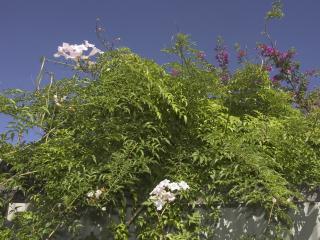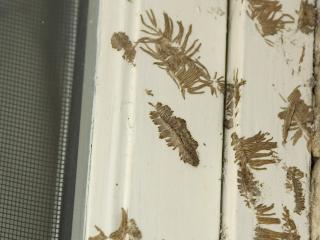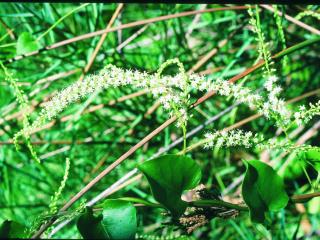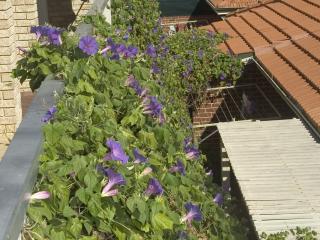When invasive climbers are established they may be extremely difficult to remove, particularly if they have invaded buildings and boundaries or escaped into a neighbouring property or the bushland beyond.
How plants climb
Some plants are routinely called “climbers” while others are usually termed “creepers” because, primarily, they creep across the ground. Many creepers, however, grow upwards if they find a suitable support, and effectively become climbers. For the purposes of this article, any plant that can grow up over other plants or manmade objects will be called a climber.
Plants climb by various methods. Some produce long, strong stems that arch over any supporting structure and then form a large, bushy crown. Some have tips that twist clockwise or anti-clockwise, threading their way through wire, trellis or shrubs and trees. Some use tendrils or hook-like thorns to gain a foothold every few centimeters as they rise. Others produce aerial roots that adhere to firm surfaces.
Why some climbers cause problems
Once a climber is well established, it can develop great mass and cause considerable damage as well as nuisance value.
The spread and volume of growth may smother shrubs and trees, robbing them of light and eventually killing them. The weight can force fences to lean and collapse. Dense tangles of plants are the perfect hiding place for rats and paper wasps. Thick growths of evergreen climbers near windows or on pergolas prevent light and warmth entering rooms or courtyards in winter. Shoots can invade roofs and block gutters, creating fire hazards in dry weather or pools where mosquitoes breed during wet periods. Aerial roots exude a substance that etches brickwork and weakens mortar.
Climbers that require discipline
Some climbers are so well-loved that it would be unreasonable to suggest people avoid them altogether. However, to lessen the chances of problems developing, take care when locating these plants and prune them regularly. Tempting though it may be to let climbers intermingle, it is better to keep them separate. If later you decide one must be removed, it is inconvenient to have to unravel mixed plant material, particularly if a thorny plant is involved.
Examples of popular climbers which frequently become rampant are cape honeysuckle (Tecomaria capensis), Japanese honeysuckle (Lonicera japonica), orange trumpet creeper (Pyrostegia venusta), Chinese trumpet vine (Campsis x tagliabuana), coral vine or Mexican rose (Antigonon leptopus) and black-eyed Susan (Thunbergia alata).
Also capable of causing problems are the four climbers listed below. They have been singled out for further description simply because so many people are won over by their beauty but later may regret having planted them in the wrong location.
Bougainvillea
Bougainvillea is a scrambling shrub rather than a climber, but its strong thorns latch onto any support and help it reach great heights. Those thorns make pruning dangerous, which may explain why many people let bougainvillea grow unchecked.
Pruning ruthlessly after flowering makes bougainvillea blossom more profusely the following season. More importantly, hard pruning removes the long canes, which are of concern if they arch over a neighbour’s wall or your front boundary, since they often descend so low that they can scratch people’s faces.
There are alternatives to having monster bougainvilleas that crush the fence or make corners of the garden inaccessible. Standard forms are commercially available. So, too, are dwarf cultivars that can be container-grown – but remember, the fact that a form is described as dwarf does not mean it needs no pruning.
Climbing roses
As with bougainvillea, a disadvantage of many climbing roses (Rosa species and cultivars) is their thorniness. Try to choose an almost thornless cultivar or, if the climbing rose that you want is thorny, plant it where it will not snag people’s skin and clothes. Begin training a climbing rose soon after planting it, being especially mindful of long, unruly canes – bend these to match the direction of growth that you wish to encourage.
Pink trumpet vine
With its glossy foliage and big flower clusters, pink trumpet vine (Podranea ricasoliana) is deservedly popular in many home gardens but, when placing it, you should bear in mind its vigorous habit.
It can send suckers under the neighbours’ fence. It can send arching stems up and over the fence, and they take root wherever they touch the soil. The shoots are strong enough to force fence panels apart, and the growth at the top of the plant – which can reach 3.5 metres in height – is heavy enough to make fences lean.
Being evergreen, this is an ideal a screening plant. As such, it may be better planted on the street frontage rather than on your neighbours’ boundary. Pruning in winter and again in early summer is the minimum requirement, but may not be enough to curb excess growth.
Wisteria
At first, wisteria (Wisteria sinensis) is slow-growing, but then it accelerates. Over many years it spreads extensively and develops thick woody branches. People tend to train wisteria across timber pergolas or veranda fascias because, being deciduous, it casts shade in summer but lets sun in during winter.
If the structure is old or weak, the weight of the plant may bring it down eventually, so check the stability of the support before planting wisteria. Also be aware that as the woody stems thicken over the years, they can force beams apart.
Prune after spring flowering and in autumn to remove soft shoots but, if size is the problem, prune again in winter to reduce the sheer mass. Like bougainvillea, wisteria can be trained as a standard. It will need support and regular pruning in the early years, but the result should be a beautiful feature plant.
Climbers to avoid
Some climbers are rarely or never available commercially because they are notorious garden escapees that invade bushland. However, they still exist in older gardens. Owners of large, unkempt gardens can sometimes be unaware that they have problematic plants and may offer you cuttings or seeds. Turn them down. Generally, the only perceived advantage of these climbers is rapid coverage, but their extreme vigour soon overwhelms most other plants and structures.
These climbers include dolichos pea (Dipogon lignosus), cape ivy (Delairea odorata), climbing groundsel (Senecio angulatus), balloon vine (Cardiospermum cordifolium), cat’s claw (Macfadyena unguis-cati) and moth vine (Araujia sericifera).
Blue or pinkish-mauve flowered morning glory (Ipomoea cairica and I. indica) smothers most other plants and, if planted to cover an aviary, has been known to kill birds when its toxic seeds drop into the enclosure and are eaten.
Various ivies are rampant. The worst – and drabbest – is English ivy (Hedera helix). Even if you remove it from brickwork, the remnants of its aerial roots adhere for years unless you can shift them with a stiff brush. Ivy smothers trees so that they eventually die and fall. It also enters roofs, gutters and drains.
Madeira vine’s swift spread is helped by aerial tubers that drop to the ground and produce fresh plants.
Several ornamentals related to edible asparagus run out of control. Bridal creeper (Asparagus asparagoides) smothers shrubs and trees, while its tuberous mat prevents water reaching them. Sicklethorn (A. falcatus) at first appears to have a lax habit, but recurved hooks allow it to climb for metres. These hooks also make it difficult to pull out without lacerating your hands and arms. Asparagus fern (A. plumosus) has a similar habit and finer but equally sharp prickles.
Confusing behaviour
Occasionally even experienced gardeners get tricked by plants with which they believe they are familiar. Following are two good examples.
Many people know creeping fig (Ficus pumila) as an indoor foliage plant. Trained on a small support and continually trimmed, it is so neat that it can be used for topiary. When allowed to cover walls, however, it acts like ivy (see above). If shoots enter fine cracks, they expand and widen the gaps.
Most ornamental passion flowers (Passiflora species and cultivars) are well behaved; so, too, is the good eating passionfruit (P. edulis) which is usually grafted onto blue passion flower (P. caerulea) rootstock. However, if the passionfruit stem above the graft is damaged, suckers emerge from the rootstock. People mistakenly encourage this new growth, but it will grow rampantly without ever producing delicious fruit.
Removing unwanted climbers
Rogue climbers sometimes have to be removed. In some cases, glyphosate will kill, though it may take repeat applications. Some people prune first but this is counter-productive, since glyphosate works more effectively if there is plenty of foliage.
Ivy is almost impossible to remove entirely. Glyphosate will brown the foliage but not necessarily kill the plant. Cut through stems at about waist height to kill the growth above, to make it easier to pull down. Digging out roots may take years. Madeira vine and bridal creeper are virtually impossible to eradicate because tubers will remain in the soil.
If a climber is too high to reach easily or has entered a roof, get it removed by a specialist who has adequate insurance in case of accident. With a climber growing on a neighbours’ property, all you can do is tell the owners if it causes problems. Even if they are sympathetic, they may have difficulty removing the plant.
Unwanted climbers or any other garden material should never be dumped in bushland or taken to the tip in an open trailer from which seeds or cuttings could drop onto roadsides. Put prunings in the bin or on the verge if a green waste collection is imminent.
Climbers in our changing lifestyle
High density housing is increasing. Often this means outdoor space is reduced to a tiny courtyard or just a balcony. People moving from an old quarter acre block to a unit, townhouse or apartment may be tempted to bring cuttings from their previous garden or to buy the same plants, to create a feeling of familiarity.
Climbers especially should be scrutinised before being introduced to a restricted space. Planting them in containers may be an option, but still you should monitor their speedy spread into the next door courtyard or over the balcony and into the visual space of the residents below. Bear in mind also that vigorous plants often resent confinement and may protest by cracking their pots or sending roots into drains.
Trustworthy climbers
Fortunately, plenty of climbers provide decent coverage without overwhelming. They include jasmine (Jasminum polyanthum and J. azoricum), Brazilian jasmine (Mandevilla sanderi), star jasmine (Trachelospermum jasminoides), white potato creeper (Solanum jasminoides), running postman (Kennedia prostrata), snail creeper (Phaseolus caracalla), snake vine (Hibbertia scandens), rata vine (Metrosideros diffusa), purple coral pea (Hardenbergia violacea), bleeding heart vine (Clerodendrum thomsoniae), and many more. Ask your nursery or garden centre staff to recommend the climber that is most suitable for your garden or outdoor space.







